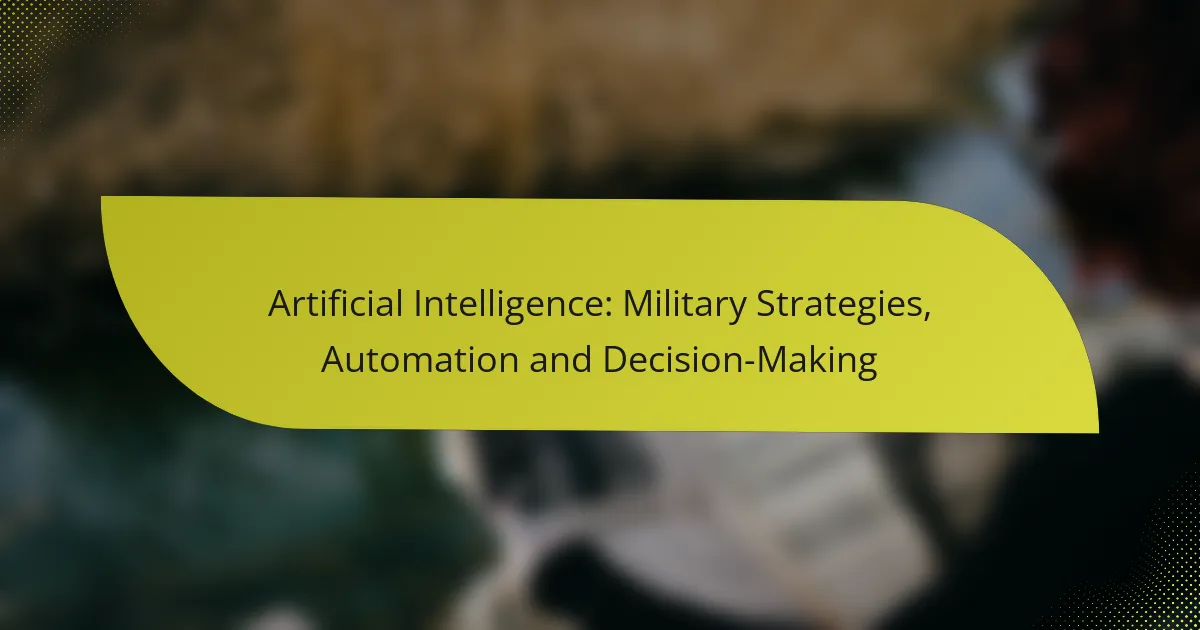Artificial intelligence (AI) is transforming military strategies by enhancing decision-making and automating combat functions. With improved threat assessments and real-time data analysis, AI enables armed forces to respond swiftly to evolving battlefield conditions. This integration not only increases operational efficiency but also reduces human error, ultimately leading to significant cost savings and optimized resource allocation.
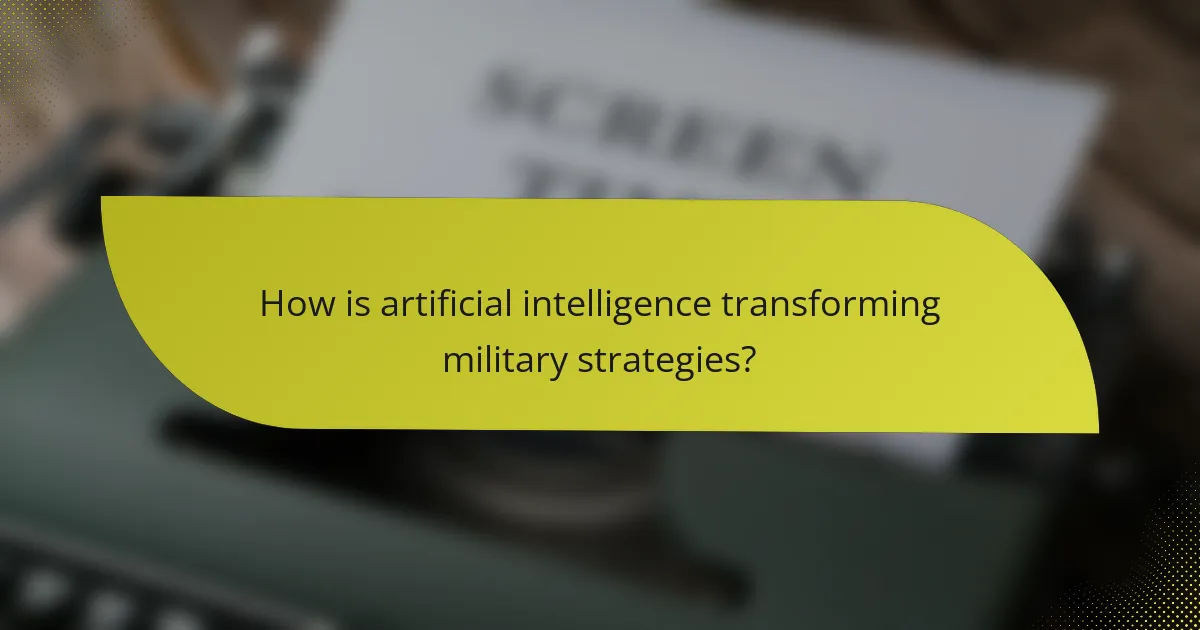
How is artificial intelligence transforming military strategies?
Artificial intelligence (AI) is significantly reshaping military strategies by enhancing decision-making processes, improving threat assessments, and automating various combat functions. These advancements enable armed forces to respond more effectively to dynamic battlefield conditions and emerging threats.
Enhanced battlefield decision-making
AI enhances battlefield decision-making by processing vast amounts of data quickly and accurately. Military leaders can leverage AI algorithms to analyze real-time information from various sources, enabling them to make informed decisions faster than traditional methods.
For example, AI can evaluate troop movements, weather conditions, and enemy positions simultaneously, allowing commanders to adapt strategies on the fly. This capability reduces response times from hours to mere minutes, significantly improving operational effectiveness.
Predictive analytics for threat assessment
Predictive analytics powered by AI helps military organizations assess potential threats before they materialize. By analyzing historical data and current intelligence, AI can identify patterns that indicate possible enemy actions or emerging risks.
For instance, AI systems can monitor social media and communication channels to detect unusual activities or sentiments that may signal an impending attack. This proactive approach allows for better resource allocation and strategic planning.
Autonomous weapon systems
AI is driving the development of autonomous weapon systems that can operate with minimal human intervention. These systems are designed to identify and engage targets based on pre-defined criteria, which can enhance precision and reduce collateral damage.
However, the use of autonomous weapons raises ethical concerns and regulatory challenges. Military forces must ensure that these systems comply with international laws and maintain accountability for their actions on the battlefield.
Real-time data analysis
Real-time data analysis is crucial for modern military operations, and AI plays a key role in this process. By continuously analyzing incoming data from sensors, drones, and reconnaissance units, AI can provide actionable insights that inform tactical decisions.
For example, AI can integrate data from various platforms to create a comprehensive operational picture, helping commanders to visualize the battlefield and anticipate enemy movements. This capability is essential for maintaining a strategic advantage in fast-paced combat scenarios.
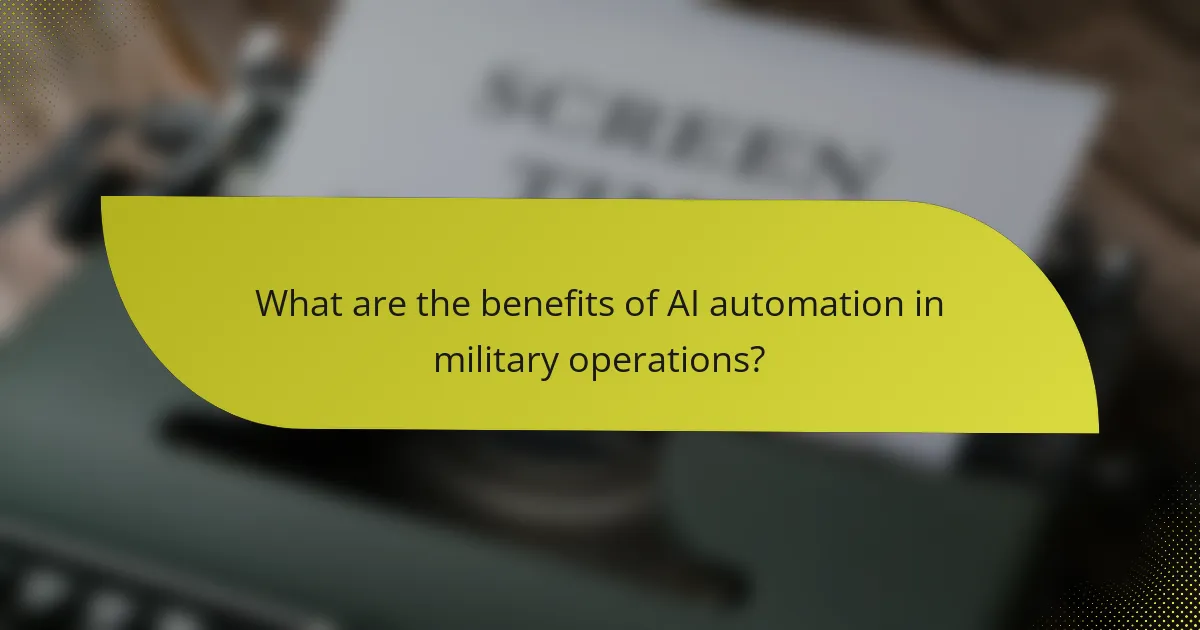
What are the benefits of AI automation in military operations?
AI automation in military operations enhances efficiency, reduces human error, and leads to significant cost savings. By integrating AI technologies, military forces can streamline processes and improve decision-making capabilities in various operational contexts.
Increased operational efficiency
AI automation allows military operations to function more smoothly by optimizing resource allocation and mission planning. For instance, AI systems can analyze vast amounts of data quickly, enabling commanders to make informed decisions faster than traditional methods.
Additionally, AI can automate routine tasks, freeing personnel to focus on more critical strategic roles. This shift not only improves response times but also enhances overall mission effectiveness.
Reduction in human error
One of the primary advantages of AI in military operations is the significant reduction in human error. AI systems can process information without the fatigue or emotional biases that can affect human judgment, leading to more accurate assessments and decisions.
For example, AI-driven targeting systems can analyze multiple variables to identify threats more reliably than human operators, minimizing the risk of collateral damage. This precision is crucial in high-stakes environments where mistakes can have severe consequences.
Cost savings in logistics
AI automation can lead to substantial cost savings in military logistics by optimizing supply chain management and resource distribution. By predicting supply needs and automating inventory management, military organizations can reduce waste and ensure timely delivery of essential materials.
Moreover, AI can enhance maintenance schedules for equipment, preventing costly breakdowns and extending the lifespan of assets. These efficiencies contribute to a more sustainable military budget, allowing funds to be redirected toward other critical areas.

How does AI improve decision-making in military contexts?
AI enhances decision-making in military contexts by providing real-time data analysis, predictive modeling, and automated insights. These capabilities allow military leaders to make informed choices quickly, optimizing operational effectiveness and resource allocation.
Data-driven insights for commanders
AI systems analyze vast amounts of data from various sources, including satellite imagery, reconnaissance reports, and social media. This data-driven approach helps commanders identify patterns, assess risks, and make strategic decisions based on current intelligence.
For example, AI can process and interpret battlefield data to highlight potential threats or opportunities, enabling commanders to allocate resources more effectively. Utilizing AI tools can significantly reduce the time spent on data analysis, allowing for quicker decision-making.
Scenario simulation and modeling
AI enables military planners to create detailed simulations of potential scenarios, allowing them to visualize outcomes based on different strategies. These models can incorporate variables such as troop movements, environmental conditions, and enemy actions, providing insights into the most effective courses of action.
By running multiple simulations, military leaders can evaluate the effectiveness of various tactics before implementation. This proactive approach helps in preparing for unforeseen circumstances and enhances overall mission success rates.
Faster response times
AI systems can process information and generate actionable insights in a matter of seconds, significantly improving response times in critical situations. This rapid analysis allows military units to react swiftly to changing conditions on the battlefield, which is crucial for maintaining tactical advantages.
For instance, AI can automate threat detection and alert personnel to potential dangers, enabling faster countermeasures. Implementing AI-driven systems can reduce decision-making delays, ensuring that military operations remain agile and responsive to evolving threats.

What are the ethical considerations of AI in military use?
The ethical considerations of AI in military applications revolve around accountability, potential misuse, and the implications of automation on decision-making. These factors raise significant questions about responsibility, the risk of unintended consequences, and the moral implications of deploying autonomous systems in combat scenarios.
Accountability in autonomous systems
Accountability in autonomous military systems is crucial, as it determines who is responsible for decisions made by AI. When an autonomous weapon system engages a target, it can be challenging to attribute responsibility for any resulting harm or violations of international law. This ambiguity can lead to a lack of accountability, complicating legal and ethical frameworks.
To address these concerns, military organizations must establish clear guidelines and protocols that define the chain of command and responsibility. Ensuring that human oversight remains integral to decision-making processes can help mitigate risks associated with autonomous systems.
Potential for misuse and escalation
The potential for misuse of AI in military contexts poses significant ethical dilemmas. Autonomous systems could be exploited for aggressive actions or to conduct warfare without adequate human intervention, increasing the risk of unintended escalation in conflicts. This could lead to rapid and uncontrollable military responses, heightening tensions between nations.
To prevent misuse, it is essential to implement strict regulations governing the development and deployment of AI technologies in military applications. International agreements and treaties could help establish norms and standards that limit the use of autonomous weapons, ensuring they are employed responsibly and ethically.
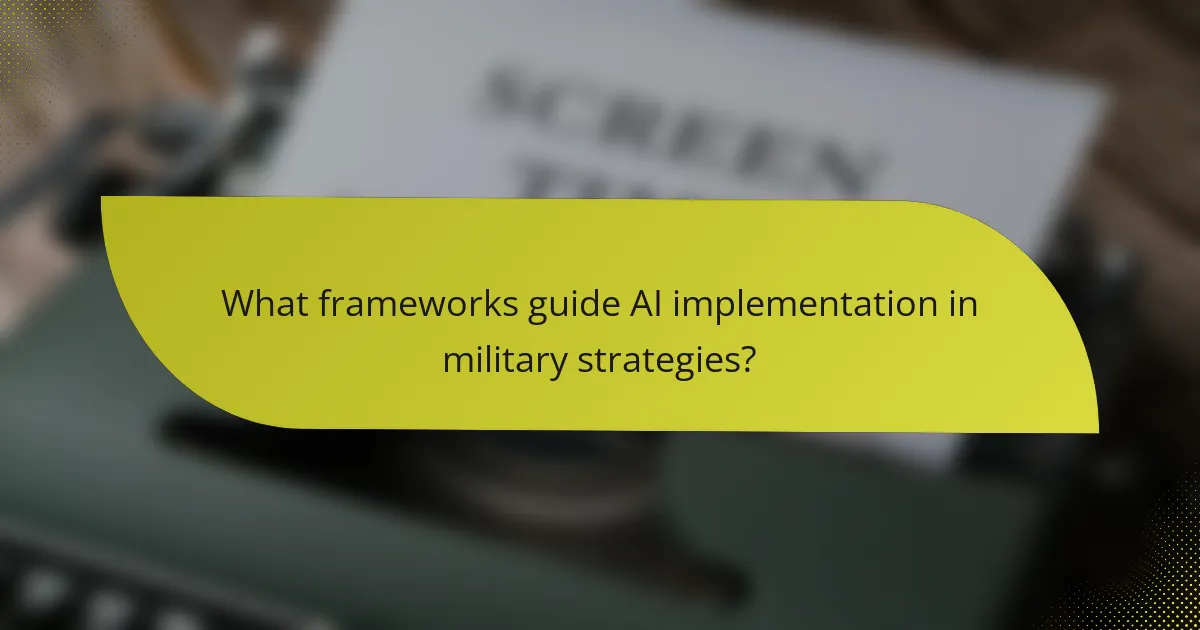
What frameworks guide AI implementation in military strategies?
AI implementation in military strategies is guided by frameworks that ensure effective integration, compliance, and interoperability. These frameworks help military organizations navigate the complexities of adopting AI technologies while maintaining operational effectiveness and security.
Regulatory compliance standards
Regulatory compliance standards are crucial for the responsible use of AI in military operations. These standards often include guidelines from international treaties, national defense regulations, and ethical considerations that govern the deployment of AI technologies. Adhering to these regulations helps mitigate risks associated with AI misuse and ensures accountability.
Common compliance frameworks include the Department of Defense’s AI Strategy in the U.S. and the EU’s AI Act, which emphasize transparency, fairness, and safety in AI applications. Military organizations should regularly review these standards to align their AI initiatives with legal and ethical expectations.
Interoperability with existing systems
Interoperability with existing systems is essential for the successful integration of AI into military strategies. This involves ensuring that new AI technologies can effectively communicate and operate alongside legacy systems, which may include various hardware and software platforms. Achieving interoperability can enhance operational efficiency and decision-making capabilities.
To facilitate interoperability, military organizations should conduct thorough assessments of current systems and identify integration points for AI solutions. Utilizing open standards and modular architectures can also promote seamless communication between AI applications and existing military infrastructure, reducing the risk of operational disruptions.
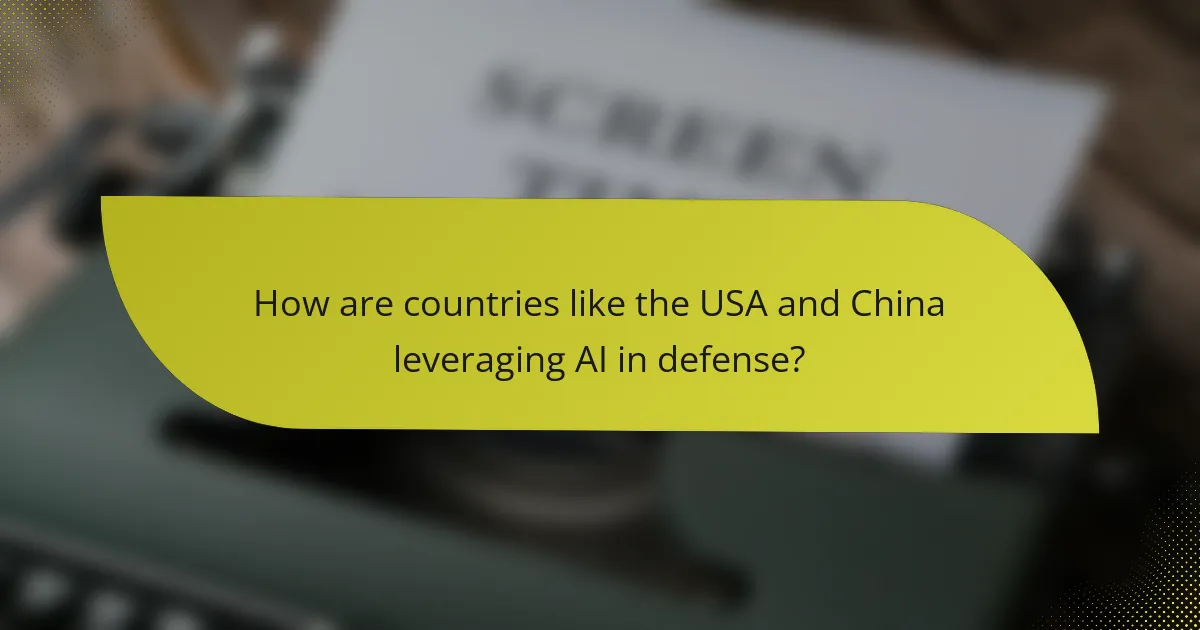
How are countries like the USA and China leveraging AI in defense?
Countries such as the USA and China are increasingly integrating artificial intelligence into their military strategies to enhance decision-making, automate processes, and improve operational efficiency. This technological shift is reshaping defense capabilities and creating competitive advantages in various military domains.
Investment in AI research and development
The USA and China are making substantial investments in AI research and development to bolster their military capabilities. The USA’s Department of Defense has allocated billions of dollars towards AI initiatives, focusing on areas like autonomous systems and data analysis. Similarly, China is prioritizing AI in its military modernization efforts, with government-backed funding aimed at achieving technological superiority.
These investments often target specific applications, such as predictive maintenance for military equipment and enhanced surveillance systems. By harnessing AI, both nations aim to reduce costs and improve the effectiveness of their armed forces.
Collaborations with tech companies
Both the USA and China are forming strategic partnerships with leading technology firms to accelerate AI integration into defense. In the USA, collaborations with companies like Google and Microsoft focus on developing AI tools for logistics, cybersecurity, and battlefield simulations. These partnerships leverage private sector innovation to enhance military capabilities.
In China, state-owned enterprises frequently collaborate with domestic tech giants to create AI solutions tailored for military applications. This approach not only fosters innovation but also ensures that advancements in AI are aligned with national defense objectives.
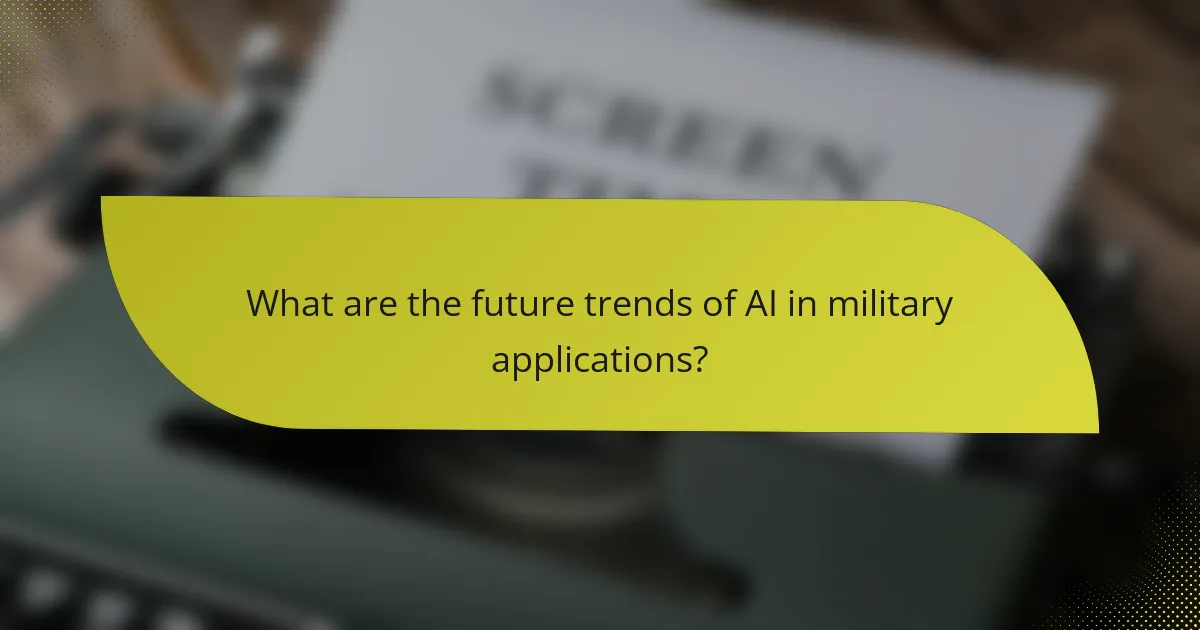
What are the future trends of AI in military applications?
The future of AI in military applications is expected to focus on enhanced automation, improved decision-making, and advanced strategic capabilities. These trends will likely transform how military operations are conducted, emphasizing efficiency and precision.
Increased Automation in Military Operations
Increased automation in military operations involves using AI to handle routine tasks, allowing human personnel to focus on more complex decision-making. This can include automated drones for surveillance and logistics, which can operate with minimal human intervention.
For example, automated systems can manage supply chains, ensuring timely delivery of resources while reducing the risk of human error. The integration of AI can also streamline maintenance processes, predicting equipment failures before they occur.
Enhanced Decision-Making Capabilities
AI enhances decision-making capabilities by analyzing vast amounts of data quickly, providing military leaders with actionable insights. Machine learning algorithms can identify patterns and trends that may not be immediately visible to human analysts.
For instance, AI can assess battlefield conditions in real-time, helping commanders make informed tactical decisions. This capability can significantly reduce response times, which is crucial in high-stakes environments.
Strategic Planning and Simulation
AI is increasingly used for strategic planning and simulation, allowing military organizations to model various scenarios and outcomes. This helps in preparing for potential conflicts by evaluating different strategies and their implications.
Using AI-driven simulations, military planners can test the effectiveness of different tactics without the risks associated with live exercises. This approach not only saves resources but also enhances readiness by providing a deeper understanding of potential challenges.
